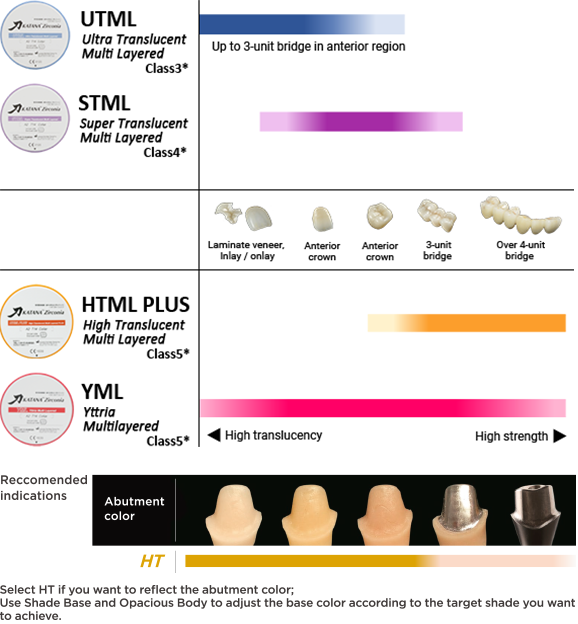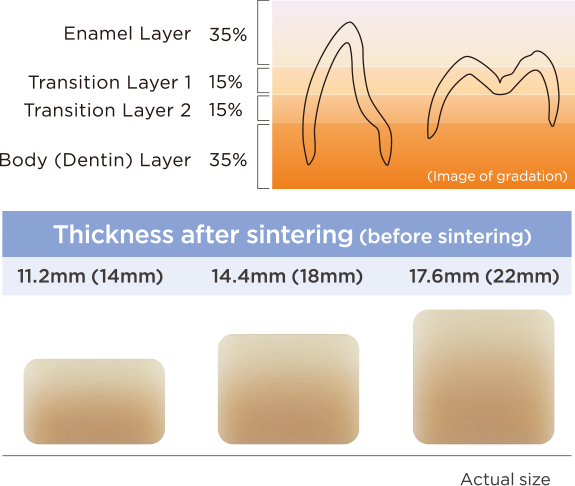-
Q01How do the mechanical properties of the “KATANA™ Zirconia” series differ from each
other?The existing “KATANA™ Zirconia” multi-layered materials ( “KATANA™ Zirconia” UTML/ STML/HTML PLUS) have a color gradation, while the base material of the respective type is the same for all layers. The strength and translucency are the same for all layers of the respective type.
“KATANA™ Zirconia” YML is different in this regard. It is the latest “KATANA™ Zirconia” multi-layered disc with a balanced combination of color/translucency and flexural strength gradation.
Please refer to chart below, for the overview of the mechanical properties and translucency levels of each type of “KATANA™ Zirconia” disc.

-
Q02What is the crystal structure?HTML PLUS has bigger ratio of tetragonal and STML and UTML has ratio of cubic.
YML the body layer has a higher content of tetragonal crystals, while the cubic content gradually increases towards the enamel layer. -
Q03Please tell me the recommended and indicated applications.The recommended and indicated applications for each series are:


-
Q04How do UTML and STML achieve
their high levels of translucency?
Do they contain glass ceramics?They do not contain glass ceramics. Their high translucency has been achieved through a new type of zirconia powder which we developed using our own unique technology. -
Q05How many color transition types are available in the UTML series?A. UTML comes in two color transition types: the “Standard Shades” and the “Enamel Shades”.
Each type has a high level of translucency through all the disc layers.
The Enamel Shades have reduced chroma in the upper layer, which allows you to enhance the translucency of the incisal area freely, where needed, by staining. UTML Shades There are two different shade groups: “Standard Shades” and “Enamel Shades”. Enamel Shades have reduced chroma in the upper layer (1) which allows you to enhance the translucent appearance of the incisal area, as desired, by utilizing external stain characterization.
-
Q06How many color transition types are available in STML?STML has only the one Standard Shade type. It does, however, also have gradations of translucency.
With this additional masking effect in the cervical area, STML will accommodate a wider range of prepared tooth stump shades than UTML. STML Shades A well-balanced combination of chromatic and gradational translucency reproduces esthetic enamel and dentin effects.
-
Q07How many color transition types are available in HTML PLUS?HTML PLUS has only the one Standard Shade type.The masking ability of the HTML PLUS is well-balanced, due to its good level of translucency with gradation of the color.

-
Q08How many color transition types are available in YML?The concept of being "lifelike", that accurately and naturally expresses the color and translucency of natural teeth.
 Q09How many shades are available for both UTML, STML, HTML PLUS and YML ?UTML is available in 20 shades; STML, HTML PLUS and YML are in 14 shades.
Q09How many shades are available for both UTML, STML, HTML PLUS and YML ?UTML is available in 20 shades; STML, HTML PLUS and YML are in 14 shades.
 Q10What are the shapes of the discs
Q10What are the shapes of the discs
in the series?Each series is supplied in the form of a flat 98.5 mm diameter disc that has a 10mm-wide plastic ring collar. You can select the appropriate disc thickness, according to the crown length needed for each clinical case. Disk thicknesses are 14, 18, and 22mm. Q11How can I tell the right side from the wrong side of the disc
Q11How can I tell the right side from the wrong side of the disc
when I am placing it in the milling equipment?The side with an “occlusal surface” sketch imprinted is the upper layer (the enamel layer).Q12Is it possible to adjust the vertical location of the gradation to suit each clinical case?Yes, you can do this utilizing various CAM software options. These options allow the designer to change the crown position within the disc profile to achieve the best gradation map for the restoration. Please refer to our “Handy Chart” for guidance.
 Q13Can I use a wet milling machine for “KATANA™ Zirconia”?It is not recommended for you to use a wet milling machine for “KATANA™ Zirconia”, as it will not achieve the desired esthetic effect.Q14What should I keep in mind when
Q13Can I use a wet milling machine for “KATANA™ Zirconia”?It is not recommended for you to use a wet milling machine for “KATANA™ Zirconia”, as it will not achieve the desired esthetic effect.Q14What should I keep in mind when
designing restorations using
STML or UTML?In case of using UTML or STML, you need to have a minimum wall thickness of 0.8 mm for anterior teeth and 1.0 mm for posterior teeth. HTML PLUS need to have a minimum wall thickness of 0.4mm for anterior teeth and 0.5mm for posterior teeth. It is also important to have the mentioned minimum thickness when you do cut-back for a porcelain overlay.
The maximum number of connected units should be limited to three anterior teeth (including a premolar) for UTML bridges and up to three posterior teeth for STML bridge. Additionally, you must provide the specified minimum connector size for each: 12㎟ for anterior bridges and 16㎟ for posterior bridges. If you want to make over 4-unit bridges, you choice HTML PLUS. You must provide the specified minimum connector size for each: 9㎟ for anterior and posterior bridges.
The recommended and indicated applications for each series are:
 Q15What should be kept in mind when designing restorations with "KATANA™ Zirconia"
Q15What should be kept in mind when designing restorations with "KATANA™ Zirconia"
YML?Please observe the following guidelines of applicable minimum wall thickness:

The thickness specifications apply to full zirconia restorations. The thickness of build-up porcelain is not included. The minimum wall thicknesses apply to full zirconia restoration or to frame-work for build-up porcelain restoration. In these cases, 0.4 mm (anterior) or 0.5 mm (posterior) should be kept for the area located in the bottom (lower) half of the disc. If full zirconia veneer restoration is used for combination with the porcelain, 0.8 mm or more should be kept for the area located in the upper half of the disc.
Please observe the following guidelines of applicable cross-section wall thickness:


3 units or less Connector cross-section area can be placed in any layer.
-
The maximum number of pontics is one. Not suitable for a cantilevered bridge. 4 units or more - at least 50% of the connector cross section should be positioned in the bottom (lower) half of the disc.
-
The maximum number of pontics between two abutments (teeth) should not exceed two. For cantilever bridge, keep the number of pontics at one. In this case, the connector cross-section must be at least 12 mm .
Q16Are the sintering schedule for "KATANA™ Zirconia" the same
as other existing zirconia products?They are different from those of other manufacturer’s zirconia products, and of our own conventional HT product. The high sintering temperature for UTML, STML, HTML PLUS and YML are 1550°C (2822°F) and the total sintering time is 7 hours. In addition to the usual sintering time (approx. 7hours), due to our proprietary zirconia technology, ”KATANA™ Zirconia” multi-layered series can be sintered in approx. 54-minute* and 90-minute* without compromising translucency or mechanical strength. *The material is removed from the furnace at 800. It is possible to fast sintering up to a 3-unit bridge. If the 54 or 90-minute sintering program is not programmable in your furnace, it is not possible to set the furnace according to one of these schedule.Q17What points should be kept in mind when removing a restoration from
the furnace?To prevent the restoration from being cracked, remove it from the furnace at 800°C and leave it on a heat sheild material such as a refractory material or glass wool until it gets cold to room temperature.Q18Regarding the rapid sintering,
is it possible to sinter 3-unit bridges?Yes, you can. 54-minute at the earliest sintering is possible for 3-unit bridge.Q19What kind of sintering furnace can be used? Can I use a sintering furnace
with a maximum sintering temperature which does not reach 1550°C (2822°F)?You cannot achieve the specified level of translucency or color development if the furnace cannot maintain 1550°C (2822°F) for at least 2 hours. If the framework was not sintered well at 1550°C (2822°F), the layered porcelain over the framework may have a risk of developing cracks. You can use any sintering furnace that can sinter at 1550°C(2822°F), regardless of the manufacturer. *If the maximum sintering temperature of your furnace is 1550°C (2822°F), please ask the manufacturer if it can be used at that temperature for a 2 hour hold time.Q20What points should I keep in mind when handling restorations after sintering?UTML’s and STML’s mechanical properties are similar to those of glass ceramics. For this reason, you should always grind them at a low rpm with a water cooling spray, being careful not to apply strong pressure. Diamond points can be used to grind, however, do not use diamond discs that can create deep cuts. If it becomes too deep, it increases the risk of cracks.Q21How should I finish the restorations?You can finish them by glazing, staining or applying a thin layer of porcelain. You can use any of the fol- lowing products for finishing, but do not mix them, otherwise, the different coefficients of thermal expansion(CTE) of the materials might cause cracks.Q22Can I finish the restorations by polishing them?Yes, you can. You can easily achieve the desired lustrous finish by using Pearl Surface Z. UTML, STML and YML are developed to finish by glazing to achieve the desired shade. If they are finished by polishing only, the final shade will develop increased chroma and appear to be a little darker than the targeted color. We recommend selecting the disk to be milled one shade brighter than the targeted finished restoration shade when polishing.Q23What exactly does “All-In-One” mean?“All-In-One” means all application range with one disc. “KATANA™ Zirconia” YML is characterized by a unique raw material combination of highly translucent zirconia with high strength, which are integrated together by an advanced manufacturing technology. As an “All-In-One” solution, “KATANA™ Zirconia” YML offers exceptional design flexibility, from long-span full-arch monolithic bridge restorations up to highly aesthetic anterior monolithic crown restorations.Q24Why is it possible to sinter “KATANA™ Zirconia” at such a high speed without
compromising optical and mechanical properties?“KATANA™ Zirconia” is characterized by the unique in-house production of zirconia raw materials. By using materials that Kuraray Noritake Dental Inc. has developed themselves specifically for the “KATANA™ Zirconia” series, completely different from those of other competitors, it is possible to realize high-speed sintering without compromising the aesthetic and mechanical properties.Q25Is it possible to speed sinter a “KATANA™ Zirconia” long span bridge?No, this is not possible. 54- or 90-minute sintering is only possible for up to a 3-unit bridge restorations.Q26Can I use any of other manufacturer’s coloring liquids on UTML or STML Zirconia?This is not recommended, as you will not be able to achieve your desired level of translucency or color development. However, our conventional zirconia product HT10 can be shaded using the coloring liquid techniques.Q27Can I adjust restorations in the oral cavity?Yes, you can. It is recommended to polish well after the occlusal adjustment is done chairside to prevent the possible wear of the opposing tooth.Q28After sintered restration, white spots occurred on the surface of restoration.When a restoration is polluted, it causes white spots before sintering. Oil from finger, air gun and silicon point residual substance of a silicon point and the scanning spray is considered as a cause. Be careful not to contaminate the restoration.


